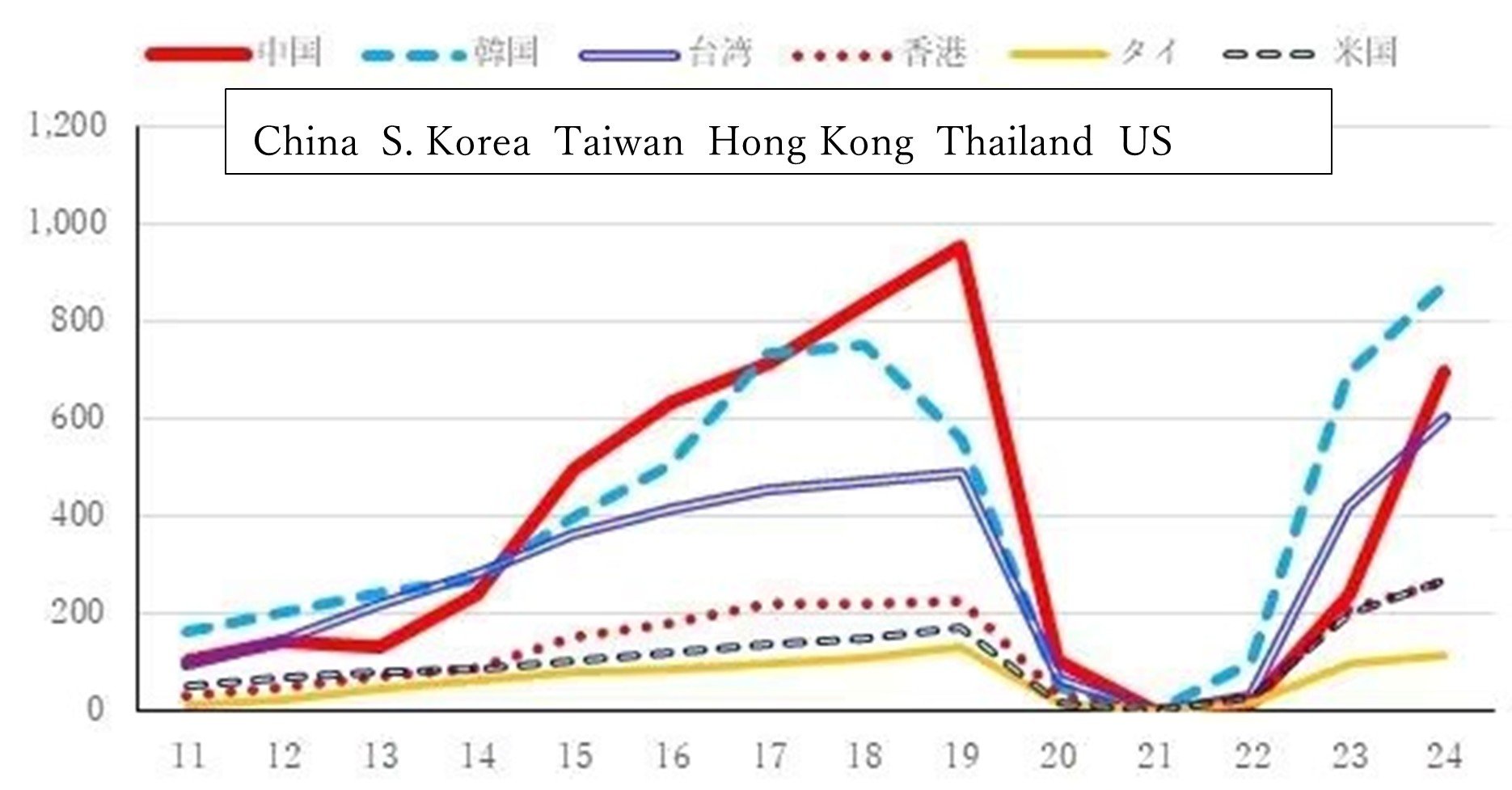1. The number of Chinese visitors to Japan hit a record high
The total number of visitor arrivals to Japan from China from January through March this year surged to 2.36 million, a record high. The figure represented a 78 percentage point increase from the same period last year.
The number of such arrivals is growing so fast that the annual total for this year will likely surpass the annual record high of 9.59 million posted in 2019. The quarterly total for the January–March period logged a 9 percentage point increase from 2.17 million for the same period of 2019.
If this pace of a 78% year-on-year increase continues, the annual total for 2025 will reach 12.4 million, much higher than the 2019 level.
This may be an overoptimistic assumption, but it is quite possible that the annual total will surpass 10 million. Because China maintained a strict zero-COVID policy from spring of 2020 to the end of 2022, the number of Chinese visitors to Japan remained quite small, standing at 1,070,000 in 2020, 40,000 in 2021, and 190,000 in 2022.
The numbers of visitor arrivals to Japan from other countries showed a similar trend (see the Chart below).

Source: Japan National Tourism Organization
From 2023 onward, the number of visitor arrivals to Japan from any country quickly recovered on the back of the subsiding of the COVID-19 pandemic. Yet the rate of recovery was somewhat low for China compared to South Korea and Taiwan.
The annual totals of visitor arrivals to Japan from South Korea and Taiwan for 2024 were both at an all-time high due in part to a weaker yen. The total for China, however, was as much as 27% lower than the peak figure for 2019.
This is interpreted to have been caused by the Chinese government’s guidance for Chinese travel agencies to curb tours to Japan.
2. Background to China’s resumption of the short-term visa exemption for Japanese visitors
After Prime Minister Shigeru Ishiba launched his administration in October 2024, Beijing’s attitude toward Japan became a conciliatory one.
This is partly because Prime Minister Shigeru Ishiba has said publicly that his political mentor is former Prime Minister Kakuei Tanaka, according to observers.
Mr. Tanaka paved the way for improving Japan-China relations. In 1972, he and Chinese Premier Zhou Enlai normalized diplomatic relations between the two countries.
Back then, China had just shifted from a controlled economy and moved onto a road toward a market economy. Technical assistance of various kinds from Japan played an important role in laying the groundwork for China’s economic development.
In talks on normalizing diplomatic relations, China refrained from demanding postwar reparations from Japan, which highly appreciated China’s stance. Leading corporations in Japan’s business world voluntarily put their efforts into providing technical assistance to China.
As the peoples of Japan and China were happy with such friendly bilateral relations, the normalization of diplomatic relations was welcomed in China as well.
The Japanese economy was vibrant in the 1980s, when China began to implement the reform and opening-up policy under the leadership of Deng Xiaoping. Japan’s economic development and corporate management were believed to serve as a model for China.
On the back of such an amicable air at the time, Japanese movies and popular songs are still loved by many Chinese people.
Many of them are in their 40s to 60s.
Former Prime Minister Tanaka is still appreciated in China because he represents the leaders of Japan of that era.
Since Mr. Ishiba declares that Mr. Tanaka is a political mentor to him, he is warmly welcomed by the Chinese side.
On top of that, Donald Trump won the US presidential election last November. Since he assumed office in January this year, there has been a growing risk that US-China relations will deteriorate further.
China rethought its hard-line stance toward Japan so that Japan would not take nothing but a pro-US stance.
It is under all these circumstances that the Chinese government resumed the short-term visa exemption for Japanese visitors at the end of last November.
Beijing also extended the visa exemption period from 15 days before the pandemic to 30 days.
3. Background to the increase in the number of inbound Chinese visitors
In response to Beijing’s short-term visa exemption for Japanese visitors, Tokyo relaxed the requirements for issuing tourist visas for Chinese visitors.
More specifically, it eased the requirements for granting multiple-entry visas for independent tourists and extended the period during which group tourists can stay on a tourist visa (from 15 days to 30 days).
In line with this move, the Chinese government is seemingly softening its guidance for Chinese travel agencies to curb tours to Japan. In fact, the number of Chinese package tourists is recovering, if slowly.
And yet, the bulk of Chinese visitors to Japan now is repeat independent visitors.
Independent tours are often more costly than package tours. Chinese visitors to Japan on independent tours tend to have higher average incomes than those on package tours.
Accordingly, the former often refrain from going on a buying cheap goods in bulk and opt rather for regular purchase of high-value added products and services that suit their tastes.
As these Chinese visitors are often high-income earners and well-educated people, they tend to demonstrate good manners in restaurants, hotels, and transportation facilities. They are less likely to get into trouble with the Japanese.
Recent media reports in Japan suggest that Chinese tourists in Japan are relatively good-mannered amid growing concerns about overtourism by foreign visitors. This reflects the characteristics of Chinese independent tourists described above.
4. Challenges Ahead
That being said, trouble between Chinese visitors and Japanese people will likely become an issue in Japan.
For one thing, it is likely that the number of cases of such trouble will be the largest for Chinese visitors even though they are less likely to cause such trouble. This is because they are expected to far outnumber visitors from other countries.
Not only that, such trouble caused by Chinese visitors will more likely invite criticism from the Japanese media than by Westerners who cause similar problems because anti-Chinese sentiment or Sinophobia remains strong in Japan.
To dispel deep-rooted mistrust between the two peoples, it is important to deepen mutual understanding and build mutual trust between them.
Direct exchanges between the Chinese and Japanese people build a basis to these ends.
A look at the traffic of people between the two countries suggests that while the number of Chinese visitors to Japan is increasing so rapidly that the annual total number will likely exceed 10 million, the number of Japanese visitors to China is not growing.
The Japan National Tourism Organization does not have statistics as to the number of Japanese visitors to China. The annual total of such visitors stood at 2.67 million for 2019, according to Chinese statistics. But this is the latest figure China released.
This figure represents less than 30% of the number of Chinese visitors to Japan.
As long as this situation continues, efforts to secure opportunities for direct exchanges, which facilitate mutual understanding between the two peoples, will need to depend substantially on Chinese visitors to Japan.
Since the launch of the Trump administration, the world has become more divided as represented by the schism between the US and Europe. The serious division increases the risk of undermining free trade and investment in the global economy and dividing the global economy itself into economic blocs.
Preventing such a state of affairs requires constant efforts to stop the deepening division of the world.
Seen in this light, it is more important than ever to promote direct exchanges at the grassroots level between the Japanese and Chinese peoples.
Japan should send a strong message of its commitment to world peace. To this end, it is important for Japan to demonstrate its own commitment to contributing to curbing the division of the world.
Such contribution would be best made by promoting people-to-people exchange, mutual understanding, and mutual cooperation between the two peoples.
Fortunately, the number of Chinese visitors to Japan is surging so fast that it is likely to exceed the all-time high. Also, I often here that the number of Japanese businesspeople visiting China has been on the rise since the beginning of this year.
It is important to promote the recent increase in mutual visits between Japan and China over the long term.
A sustained increase of such traffic will help improve bilateral relations, which in turn will increase such traffic.
What I hope going forward is that Japan and China will resume mutual visits by their national leaders, which in turn will likely give an impetus to direct exchanges between the two peoples. And I strongly hope that mutual understanding, trust, and cooperation thus increased will help stem the tide of a dividing world.
